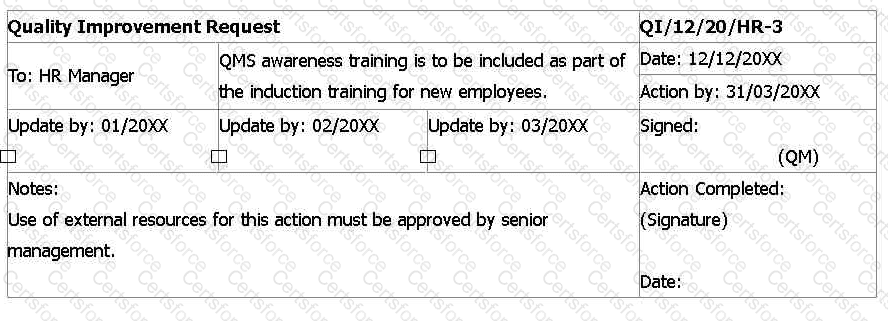Among others, what does Clause 4.4 (Quality Management System and Its Processes) of ISO 9001 require from organizations?
In the context of a third-party audit, match the event with the responsibility for conducting it.

Scenario 4:
TD Advertising is a print management company based in Chicago. The company offers design services, digital printing, storage, and distribution. As TD expanded, its management recognized that success depended on adopting new technologies and improving quality.
To ensure customer satisfaction and quality improvement, the company decided to pursue ISO 9001 certification.
After implementing the QMS, TD hired a well-known certification body for an audit. Anne Key was appointed as the audit team leader. She received a document listing the audit team members, audit scope, criteria, duration, and audit engagement limits.
Anne reviewed the document and approved the audit mandate. The certification body and TD’s top management signed the certification agreement.
Before contacting TD, Anne reviewed the audit scope and noticed that TD made changes to it due to the adoption of new printing equipment. However, Anne disagreed with the changes, stating they would affect the audit timeline. She considered withdrawing from the audit.
How do you assess the situation presented in the last paragraph of scenario 4?
A Health Trust has contracted with Servitup, a catering services organisation that has been certified to ISO 9001 for one year. It provides services to
10 small rural hospitals in remote locations involving the purchase and storage of dry goods and fresh produce, preparing meals, and loading heated
trolleys for Ward Service by hospital staff. You, as auditor, are conducting the first surveillance audit at one site with the Deputy Catering Manager
(DCM).
DCM: "I apologise for the absence of the Catering Manager. He has called in sick today and we are really short of staff."
You: "I see. It really shouldn't affect the QMS so the audit can progress as normal."
DCM: "The Catering Manager set up the system. I'm afraid I'm not as familiar with it as he is."
You: "OK, let's start with the Quality Policy. What are the main issues for the QMS here?"
DCM: "Give me a minute. I need to look at the Quality Policy on the noticeboard in his office."
As the audit progresses, it is clear that the DCM has a very low knowledge of the QMS. He continually has to look up the answers to your questions
or ask staff members about their processes. You decide to raise a nonconformity.
Select one of the following options that best describes the nonconformity.
You are conducting an audit at a single-site organisation seeking certification to ISO 9001 for the first time. The organisation manufactures cosmetics for major retailers and the name of the retailer supplied appears on the product packaging. Sales turnover has increased significantly over the past five years
You are interviewing the new Product Development Manager. You note that a software application called SWIFT is used to help control the product development process.
You have gathered audit evidence as outlined in the table. Match the ISO 9001 clause 8.3 extracts to the audit evidence.

Which of the following is correct with regard to the internal audit?
Select one option that must be considered when determining the scope of a QMS to ISO 9001.
XYZ Corporation is an organisation that employs 100 people. As audit team leader, you are conducting a
certification audit at Stage 1. When reviewing the quality management system (QMS) documentation, you
find that quality objectives have been set for every employee in the organisation except top management.
The Quality Manager complains that this has created a lot of resistance to the QMS, and the Chief Executive
is asking questions about how much it will cost. He asks for your opinion on whether this is the correct
method of setting objectives.
Three months after Stage 1, you return to XYZ Corporation to conduct a Stage 2 certification audit as Audit
Team Leader with one other auditor. You find that the Quality Manager has cancelled the previous quality
objectives for all employees and replaced them with a single objective for himself. This states that "The
Quality Manager will drive multiple improvements in the QMS in the next year". The Quality Manager indicates
that this gives him the authority to issue instructions to department managers when quality improvement is
needed. He says that this approach has the full backing of senior management. He shows you the latest
Quality Improvement Request that was included in the last management review.

After further auditing, the issues below were found. Select three statements that apply to the term 'audit trail'
You have been just hired as the Internal Lead Auditor of a large organisation, responsible for internal audits. Your first job is to analyse the answers to nonconformities included in the report of a recent internal audit to Top Management.
The report contained one nonconformity as follows:
There is no evidence of Top Management ensuring the availability of resources to operate the QMS, the establishment of objectives, the promotion of continual improvement, and the promoting of the process approach.
Which four of the following Top Management actions can be considered 'corrections to the nonconformity'?
The certification body has not been able to verify the implementation of corrective actions for any identified major nonconformity within six months after the last day of the Stage 2 audit. What must the certification body do in this case?